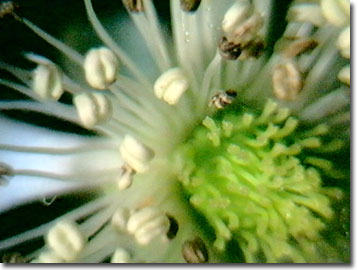Reflected Light Digital Image Gallery
Blackberry (Rubus villosus)
When the great American poet Walt Whitman wrote that the blackberry "would adorn the parlors of heaven", he had no idea that modern pharmaceutical researchers would add to his admiration. Recently, nutritionists and the medical community have examined the blackberry as a possible nutraceutical - a food that provides medical or health benefits beyond basic nutrition, including prevention and treatment of disease. Whether they are used for jellies and jams, ice cream, pies, juices, wine, or eaten raw, blackberries are the most widely used member of the caneberries.

View a second image of a blackberry (Rubus villosus).
View a third image of a blackberry (Rubus villosus).
Whether wild or cultivated on berry farms, blackberries (Rubus villosus) are rich in phytochemicals, and with the other caneberries (such as raspberry, loganberry, boysenberry, and marionberry, a very popular berry grown in Oregon), are highly rated, based on their oxygen radical absorbance capacity. Almost as well-stocked as a pharmacy, a blackberry contains phenolic, phyto-estrogen, flavonoids, vitamins, flavonols, fiber, and even salicylic acid.
The salicylic acid found in blackberries and raspberries probably has the same protective value against heart disease and strokes as aspirin. Ellagic acid, a phenolic compound, is known to influence the quality, acceptability, and stability of foods by acting as an antioxidant, colorant, and flavor enhancer and is found at levels five to six times higher in blackberries and raspberries than other fruits. In the human body, ellagic acid appears to impede cancer by blocking various hormone reactions and metabolic pathways. Much of the antioxidant powers attributed to these berries are accounted for by their anthocyanin content. The anthocyanins are the pigments that give blackberries their deep purple to black color and are within the phenolic-flavonoid class of organic compounds. As an antioxidant, anthocyanins are linked to improving vision, improving circulation, preventing cancer, controlling diabetes, and even retarding aging by preserving memory and motor skills. Known as ascorbic acid, vitamin C is a water-soluble nutrient that functions as an antioxidant, grabbing up free radicals before they wreak havoc in the body, and along with vitamin A, is found in high concentration in blackberry fruits.
Flavonols featured in blackberries include quercetin and the catechins. Both are considered antioxidants and anti-carcinogens. Additionally, quercetin may be effective for treating allergy symptoms since it reduces the release of histamines. By eating whole blackberries, a person also increases their dietary fiber intake, which leads to healthy gastrointestinal function, lower LDL cholesterol levels, and reduced risks from some cancers. The tannin content of blackberry leaves is high and has been used for years as an herbal tea for diarrhea, and since Christ's time, chewed for bleeding gums. Known also as the dewberry, goutberry, and cloudberry, the bark of the blackberry root and rhizome contains tannin (20 percent), gallic acid, and saponins, including villosin. Saponins are natural detergents or surfactants that are capable of lysing red blood cells and other wall-less cells as membrane-active agents. Gallic acid, a benzoic acid derivative used in early photography by John Herschel in 1839, is applied as an astringent and cure for passive hemorrhages by herbalists and plays important roles in wine and whiskey production.
Native to North America and elsewhere, wild blackberry plants, sometimes referred to as briars or brambles because of their nasty thorns and tangles, are upright, arching shrubs with a biennial cane that offer food and cover habitat for wildlife such as rabbits and birds. However, thornless cultivars were developed by horticulturists to ease the pain of harvest. Unusual in the plant kingdom, blossoms and fruits, both ripened and green, are visible on the same bush simultaneously. Archaeological digs in Ireland, Denmark, and England show that blackberries were important in the diets of the Vikings, and their teas were featured in the ancient Roman dispensary. A tea made with the whole blackberry plant was used by Native Americans to treat dysentery, cholera, and upset stomach. Brambles, probably blackberry, are described in the Old Testament in Jotham's parable on how the lowly plant became king of the noble olive, fig tree, and grape vine.
Contributing Authors
Cynthia D. Kelly, Thomas J. Fellers and Michael W. Davidson - National High Magnetic Field Laboratory, 1800 East Paul Dirac Dr., The Florida State University, Tallahassee, Florida, 32310.
BACK TO THE REFLECTED LIGHT IMAGE GALLERY
BACK TO THE DIGITAL IMAGE GALLERIES
Questions or comments? Send us an email.
© 1995-2025 by Michael W. Davidson and The Florida State University. All Rights Reserved. No images, graphics, software, scripts, or applets may be reproduced or used in any manner without permission from the copyright holders. Use of this website means you agree to all of the Legal Terms and Conditions set forth by the owners.
This website is maintained by our
Graphics & Web Programming Team
in collaboration with Optical Microscopy at the
National High Magnetic Field Laboratory.
Last Modification Friday, Nov 13, 2015 at 01:19 PM
Access Count Since September 17, 2002: 12928
Visit the website of our partner in introductory microscopy education:
|
|
